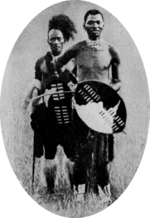Bambatha Rebellion
The Bambatha Rebellion (or the Zulu Rebellion) of 1906 was led by Bambatha kaMancinza (c. 1860–1906?), leader of the Zondi clan of the Zulu people, who lived in the Mpanza Valley (now a district near Greytown, KwaZulu-Natal) against British rule and taxation in the Colony of Natal, South Africa.
| Bambatha rebellion | |||||||
|---|---|---|---|---|---|---|---|
| Part of the aftermath of the Anglo-Zulu War | |||||||
 Zulu warriors | |||||||
| |||||||
| Belligerents | |||||||
| amaZondi and amaCube clans of the Zulu people | ||||||
| Commanders and leaders | |||||||
|
Colonel Duncan McKenzie | Chief Bambatha kaMancinza | ||||||
| Strength | |||||||
| 4,316 soldiers (including 2,978 Militia)[1] | Unknown | ||||||
| Casualties and losses | |||||||
| 36 (including 6 levies)[2] | 3,000 to 4,000 killed | ||||||
Overview

In the years following the Anglo-Boer War, British employers in Natal had difficulty recruiting black farm workers because of increased competition from the gold mines of the Witwatersrand. The colonial authorities introduced a poll tax £1 (equivalent to £110 in 2019) in addition to the existing hut tax to pressure Zulu men to enter the labour market.[3]
Bambatha had occasionally been in trouble with the Natal colonial administration, and the authorities suspected that he had joined with other chiefs in expressing discontent over the tax. He was summoned to Greytown, but, fearing arrest, did not attend. He realised that the administration was intent on crushing dissent and fled to Zululand to consult with King Dinizulu.[4] Bambatha returned to the Mpanza Valley to discover that the Natal government had deposed him as chief.[3] He gathered together a small force of supporters and began launching a series of guerrilla attacks, using the Nkandla forest as a base.[3]
The British succeeded in getting face to face with and surrounding the rebels at Mome Gorge. As the sun rose, colonial soldiers opened fire with machine guns and cannon, on rebels mostly armed only with traditional assegais (spears), knobkerries (fighting sticks) and cowhide shields.[3] It was reported that Bambatha had been killed and beheaded by Natal government forces, but this claim was disputed by his supporters, who believed that he fled to Mozambique.[5]
The war cost the Natal government £883,576[6] (equivalent to £96,000,000 in 2019).
Mahatma Gandhi's role
| Amount actually collected from the poll tax between 1906 and 1909[7] | ||||
|---|---|---|---|---|
| 1906 | 1907 | 1908 | 1909 | |
| Natal | ||||
| £68,500 | £49,637 | £45,150 | £41,498 | |
| Zululand | ||||
| £7,990 | £4,267 | £3,940 | £3,520 | |
| Total | ||||
| £76,490 | £53,904 | £49,090 | £45,018 | |
Mohandas Karamchand Gandhi, who was in South Africa at the time, felt that the Indians in South Africa would do best for themselves to serve the British Empire as a reserve force in the Army against the Zulu uprising.[8] Gandhi actively encouraged the British to recruit Indians. He argued that Indians should support the war efforts in order to legitimise their claims to full citizenship. The British, however, refused to commission Indians as army officers. Nonetheless, they accepted Gandhi's offer to let a detachment of Indians volunteer as a stretcher bearer corps to treat wounded British soldiers. This corps of 21 was commanded by Gandhi. Gandhi urged the Indian population in South Africa to join the war through his columns in Indian Opinion: "If the Government only realised what reserve force is being wasted, they would make use of it and give Indians the opportunity of a thorough training for actual warfare".[8] Later in 1927 he wrote of the event as "No war but a man hunt".[9]
Commemoration
In 2006, the hundredth anniversary of the rebellion was commemorated in a ceremony which declared Chief Bambatha a national hero of post-Apartheid South Africa. Also, his picture appeared on a postage stamp and a street was renamed in his honour.[3]
According to speeches in the ceremony, the beheaded body had not really been Bambatha's and the actual chief succeeded in escaping to Mozambique. This belief is still widely current; a DNA test of his alleged body failed to give a definite answer.[10]
The hip-hop musician Afrika Bambaataa takes his name from Bambatha and his rebellion.[11]
See also
- First Boer War (1880–1881)
- Natal Native Rebellion Medal (1907)
References
Citations
- Stuart 1913, p. 548.
- Stuart 1913, p. 540.
- Hennop 2006.
- "Chief Bhambatha kaMancinza Zondi | South African History Online". www.sahistory.org.za. Retrieved 19 September 2015.
- "Chief Bhambatha kaMancinza Zondi | South African History Online". www.sahistory.org.za. Retrieved 19 September 2015.
- Stuart 1913, p. 550.
- Stuart 1913, p. 131.
- Gandhi 1961, p. 175, Indian Opinion.
- Gandhi 2009, p. 500.
- Bishop 2004.
- Anon. 2017.
Sources
- Anon. (6 June 2017). "Afrika Bambaataa, Disc Jockey (1957–)". The Biography.com website. A&E Television Networks. Archived from the original on 22 October 2018.CS1 maint: ref=harv (link)
- Bishop, Craig (11 October 2004). "DNA test fails to identify Zulu rebel prince". IOL News. Retrieved 23 February 2019.CS1 maint: ref=harv (link)
- Gandhi, Mahatma (1961) [1906]. Collected Works of Mahatma Gandhi. Vol. 5 : 1905-1906. Government of India.CS1 maint: ref=harv (link)
- Gandhi, M. K. (2009). An Autobiography: The Story of My Experiments With Truth. The Floating Press. ISBN 978-1-77541-405-6.CS1 maint: ref=harv (link)
- Hennop, Jan (9 June 2006). "SA to mark historic Zulu rebellion". Independent Online. Archived from the original on 12 July 2006.CS1 maint: ref=harv (link)
- Stuart, James (1913). A History of the Zulu Rebellion 1906: And of Dinuzulu's Arrest, Trial, and Expatriation. London: Macmillan.CS1 maint: ref=harv (link)
Further reading
- Vandervort, Bruce (2004). "An Historical Atlas of the Zulu Rebellion of 1906 (review)". The Journal of Military History. 68 (3): 974–975. doi:10.1353/jmh.2004.0155. ISSN 1543-7795.CS1 maint: ref=harv (link)
| Wikimedia Commons has media related to Bambatha Rebellion. |